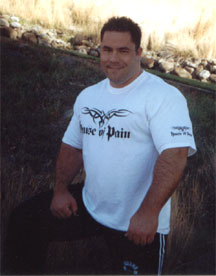 An interview with 2003 Arnold Classic Benchpress Champion & the
An interview with 2003 Arnold Classic Benchpress Champion & the
1st man to benchpress 800 pounds, Ryan “Bench Monster” Kennelly
Winter had come again and the streets of the north were covered with ice and snow. We had loaded up our truck and trailer and were rolling southeast, through Idaho and Montana on our way to Las Vegas to attend again the WABDL benchpress & deadlift world championships. As we made our way across winter’s barren landscape, I stared out the window at the snowy fields and wondered what this week’s competition would bring. Ryan “Bench Monster” Kennelly was to return to the platform after many months of secluded training, to take a trek into the newly charted land of the 800’s. Every time a world champion steps in the arena, the historians are poised in anticipation, waiting to see if barriers, or men, will be knocked to the ground.
In the competition hall, we’d built an island of booth tables directly in line with the front doors. This vantage point allowed me to watch the river of lifters and fans as they flowed from the casino into the tradeshow hall. From the end of the city block long walkway I could see Kennelly appear, like a freighter amongst a sea of boats. At 6’4, he again showed up weighing just over 300 pounds, but this time, his back was denser and his triceps all the more massive. The Bench Monster’s framework told the story of someone who’d lived in the gym and who’d spent countless hours sitting at the training table devouring plates of steaks and blenders full of protein shakes.Gym bag in hand, he made his way through the crowd and back into the warm-up area. Before long, one of the lifters from a finished flight hurried up to our booth and said “You gotta come back stage and see this!” I rushed back to the training hall in time to see Kennelly finish warming up on the bench. 400, 500, 600 pounds was being piled onto the bar and, set after set, the reps were blasting off of his chest like an empty bar. One of the coaches standing next to me said “I’ve never seen a six hundred pound barbell move that fast.” “NEVER” he repeated to emphasize the phrase.
The master of ceremonies announced that it was time for the superheavyweights to begin and so the giants lumbered towards the platform to line up off stage. Powerlifting flights go in the order of lightest to heaviest weights attempted, so Kennelly was last up with his opener being in the mid-700’s. With a flaming skullcap pulled down to his steel gaze, he set up on the bench, took the ponderous load out of the rack, lowered the bar to his chest and then jackhammered it back up into lockout. The lift appeared effortless and the crowd roared with anticipation of the greater lifts to come. Up till this day, Kennelly’s best had been an amazing 800.5 pounds. Feeling bull strong, he called for the bar to be loaded with a record breaking 804. Again, he set up on the bench and prepared to do battle with the iron. Lifting off 804 pounds properly is an arduous task, and Terry Leuhrs (a powerlifting guru, himself weighing well over 300 pounds) stumbled with the load, his knee dropping into the side of Kennelly’s head as he tried to take control of the lift. The bar twisted in the air and was now running diagonally over Kennelly’s chest. I looked for him to rerack and then rest up for his third attempt but, instead, he began lowering the weight into the pressing position! Again, the weight shot off of his chest with fiery force, but the previous balancing act proved to have been too much of a strain and the lift stopped before it could be locked out. Kennelly came up off the bench and I saw his face flushed and his eyes red with broken vessels. We all went back to the warm-up room to regroup and plan the third round assault. “No worries” Kennelly told us “the weight didn’t feel heavy and I’ll get it this time.”
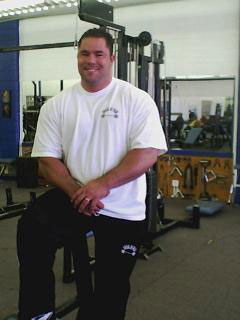
The commentator’s voice sounded over the speakers and the Bench Monster strode out onto the platform for another run at victory. At this point, the poundage had gotten so serious that the crew of spotters was now made up of powerlifting all-stars Jason “Action” Jackson (who benchpressed 672 pounds at 242 pounds bodyweight the same week), Brent “Sgt. Rock” Howard (multiple WABDL world champion who deadlifted 738 pounds at 242 pounds bodyweight the following day) and Ron “Lionheart” Palmer (at the WPO Finals, he squatted 788, benchpressed 474 and deadlifted 688 pounds at 165 pounds bodyweight). Again the bending bar was taken out of the rack and, this time, the handoff delivered by the monstrous Leuhrs was flawless. Kennelly perfectly controlled the weight on the way down and placed it just below his chest line. “PRESS!” came the command from the head judge and the iron stick blasted off the Bench Monster’s chest and up into lockout. The crowd went beserk as Kennelly hammered up the most impressive 800+ benchpress in history. The victory was his and he walked to the edge of the stage to look out onto the legions of strength fanatics and to acknowledge that he was one of them and that he respected their dedication to the sport of heavy iron.
The day after the competition, we settled into the Peppermill Lounge across the street and began working on the next BodyTalk article over platters of steaks and baked potatoes. In this paper, we cover building a 315 pound benchpress into a 405, grip widths for benchpress training, controlling the bar on the descent, hardcore training for gym rats who aren’t yet using bench shirts, nutrition strategies for muscle mass & strength and much, much more. I hope that you enjoy the read and I look forward to seeing you at the next strength show.
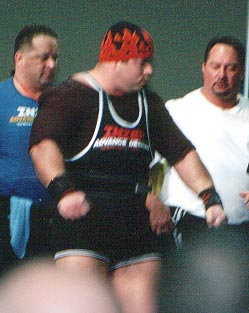
Seanzilla: In the last article we did for BodyTalk (October-December 2003 issue), we covered benchpress training up to a 315 pound max benchpress. Now, for lifters who’ve achieved that goal over the last six months, please write out a program to take them through the 405 pound barrier.
Kennelly: If you have followed my previous training article for Eclipse, and have successfully become a 315 pound max benchpresser, here is the next step in your training program. In addition to the one heavy day per week that you did previously, you will incorporate a speed benchpress day. Your benchpress training schedule will be speed day, three days off, heavy day, three days off, repeat. On your speed day, you will use 60% of your one rep max (without a benchpress shirt). So, if 315 pounds is your one rep max, you will perform 8 sets of 3 reps with 190 pounds. Give yourself a one minute rest period between sets (on your heavy training day, you can rest up to ten minutes between sets depending on your level of fatigue). For these sets, you will use a close grip for the first 3 sets, then move your grip out to a medium close grip for the next 3 sets and then finish up the last two sets with your competition grip. You must perform these reps fast, but with control. Have someone time you with a stop watch and make sure that you get your three reps in or under 3 seconds. If you can’t bench the weigth 3 times in 3 seconds, then the weight is too heavy and should be lowered.
This style of training will develop your fast twitch muscle fibers and explosive power in the benchpress. Which exercises you choose for your assistance work, after your speed benching, is up to you. Just limit yourself to two tricep exercises and keep the reps in the 10-15 per set range. After 12 weeks of this training, you will need to see what your new raw max is and then adjust your percentages for your speed work. For example, after 12 weeks you may have a new raw max of 330, so your speed benching weight will now be 200 pounds. In our next article, I will introduce bands and chains into your speed training! So get busy.
For your heavy benchpress day, you’ll rotate the following four different training days (training each heavy day version two weeks in a row). Day 1: Close Grip Benchpress 4×8, Dumbbell Floor Extensions 10×6, Front Barbell Shoulder Raises 3×10, Dumbbell Hammer Curls 5×5 Day 2: Board Presses with 2, 3, or 4 Boards 8×3, Decline EZ Curl Skull Crushers 6×10, Front Dumbbell Raises 3×10, Side Dumbbell Raises 3×10, Dumbbell Hammer Curls 5×5 Day 3: Decline Benchpress 4×8, Behind-The-Neck Dumbbell Tricep Extensions 5×5, Front Shoulder Raises w/a 24, 35, or 45 Pound Plate (keep the movement slow and controlled) 3×10, Dumbbell Hammer Curls 5×5 Day 4: Incline Benchpress 3×10, Floor Presses 5×5, Upright Rows 3×10, Dumbbell Hammer Curls 5×5
Note: In regards to the bench sets that you put in on your heavy days, you shouldn’t miss any reps, but the weight should be heavy enough that the last rep of each set is tough to get. If the last rep of a set is still somewhat easy, then increase the weight for the next set. Also, don’t forget to warm-up before you start your working sets.
Seanzilla: In the gym, I’ve seen people benchpressing with a wide variety of grip widths. What different grip widths do you train with and when?
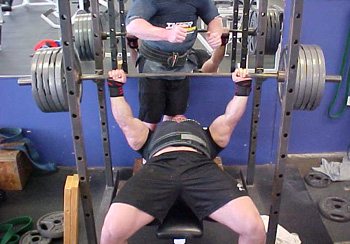
Kennelly: In the style of training that I’ve developed, we use 3 different grips; close, medium, and competition. Because barbell designs vary so much, in reference to where the knurling starts and stops and where the guide rings are placed, it’s difficult to describe to someone the widths of these three grips. So, figure out where you like your grip to be when you press for a max rep and call that your competition grip. Then, your medium grip will be two inches in from there and your close grip will be two more inches in from there. The close grip is mostly used when training the head of the triceps for example, when performing 4 board and 5 board presses. The medium grip is used in every other training lift that we perform in the gym. The competition grip is used at the end of the training cycle prior to the competition and during the competition itself. The close & medium grips will really make your triceps very strong and your explosive speed will increase once your triceps adapt to the workloads..
Seanzilla: When the weight on the bar gets heavy, a lot of lifters have trouble controlling the bar’s descending portion of the press (the weight comes down too fast or gets out of the groove). If this happens, what does the lifter need to work on and how?
Kennelly: To properly lower heavy weight you must use your lats and you need to keep your shoulder blades together as the bar decends. Also, keep your elbows in the 8 o’clock and 4 o’clock position (with your head being in the 12 o’clock position). Your elbows should never be in the 9 o’clock and 3 o’clock position on the way down with the bar. Most people lower the bar with their front delts (shoulders) which is what happens on a majority of failed bench attemps.

So, to recap, once you set up on the benchpress, pinch your shoulder blades tightly together and keep them that way through the duration of the press. After you’ve gotten your handoff and the bar is lined up properly with the starting point of your descent, you will lower your elbows to the 8 o’clock and 4 o’clock positions while squeezing your upper arms into your lats (not your elbows into your lats). What’s also important is to keep your head pressed against the bench and not following the travel of the bar. Lifting your head and watching the bar will take you out of your groove and you will lose your base. Keeping your head pressed back into the bench will also help you keep your back arched and your shoulders, lats ,and triceps all in your power line. In training, you must practice this benchpress technique and master it. Don’t wait until a contest to try out your competition form, practice it with every rep! You should also train in your benchpress shirt when attempting heavy negatives (bringing 1RM and above 1RM weight down to your chest) but, only perform this drill once per month, as it is very taxing on the body to do heavy negatives.
Seanzilla: Over 90% of competitive powerlifters train with and use benchpress shirts in competition. There are some powerlifters though, and a lot of bodybuilders and gym lifters, who are training for a bigger max benchpress and who don’t plan on using bench shirts (not using a bench shirt is dangerous over time and can lead to pec tears and shoulder injuries). What would you suggest for a lifter who’s going for a bigger max benchpress without a shirt?
Kennelly: Here is the new unassisted (no bench shirt) routine that I have worked on and that I have had all of my training partners try out over the summer. By the end of the summer (a 3-4 month training cycle) every one of my guys was able to do three sets of three reps with their previous one rep max! This workout should be done as your heavy bench work out. and for assistance work, you should keep it simple and brief due to the extreme work load this routine puts on your body as the training intensity progresses in this cycle.
Heavy Bench Day Week #1: Work with 50% of your one rep raw max and you will do 8 sets of triples at this weight. So, for example, if you’re 1RM is 300 pounds, you’ll do 8 sets of 3 reps with 150 pounds. For your assistance work, perform 5 sets of 5 with a four board press, using 80% of your 1RM. Then, do 3 sets of 12-20 reps of tricep cable pushdowns.
Heavy Bench Day Week #2: Work with 55% of your one rep max and perform 8 sets of triples. So, going off of our example of a 300 pound 1RM, do 8 sets of 3 reps with 165 pounds. Again, for your assistance work, do 5 sets of 5 reps with a four board press, using 80% of your 1RM and then do 3 sets of 12-20 reps of tricep cable pushdowns.
Heavy Bench Day Week #3: Work with 60% of your one rep max and perform 8 sets of triples. As per the above 300 pound 1RM, do 8 sets of 3 reps with 180 pounds. For your assistance work, do rack lockouts for 5 sets of 5 reps and with 80% of your 1RM. Then, perform skull crushers for 3 sets of 12-20 reps.
Heavy Bench Day Week #4: Work with 65% of your one rep max and perform 8 sets of triples. In our example workout (300 pound 1RM) you’d do 8 sets of 3 reps with 195 pounds. Your assistance work this week will be a repeat of Week #3; rack lockout for 5 sets of 5 using 80% of your benchpress 1RM and then skull crushers for 3 sets of 12-20 reps.
Heavy Bench Day Week #5: Train with 70% of your one rep max and perform 6 sets of triples. Example workout: 6 sets of 3 reps with 210 pounds.. Your assistance work this week will consist of floor presses for 5 sets of 5 and using 50% of your benchpress 1RM and then behind-the-head 2 hand dumbbell extensions for 3 sets of 12-20 reps.
Heavy Bench Day Week #6: Work with 75% of your one rep max and perform 6 sets of triples. Example workout: 6 sets of 3 reps with 225 pounds. For assitance work, repeat what you did on Week #5: floor presses for 5 sets of 5 using 50% of your 1RM and then behind-the-head 2 hand dumbbell extensions for 3 sets of 12-20 reps.
Heavy Bench Day Week #7: Train with 80% of your one rep max and perform 3 sets of triples. Example workout: 3 sets of 3 reps with 240 pounds. Your assistance work for this week will be weighted dips for 3 sets of 8-12 reps and then barbell extensions off the floor for 3 sets of 10-15 reps.
Heavy Bench Day Week #8: Train with 85% of your one rep max and perform 3 sets of triples. Example workout: 3 sets of 3 reps with 255 pounds. For assistance work this week, repeat what you did on Week #7: performing weighted dips for 3 sets of 8-12 reps and then barbell extensions off the floor for 3 sets of 10-15 reps.
Heavy Bench Day Week #9: Train with 90% of your one rep max and perform 3 sets of triples. Example workout: 3 sets of 3 reps with 270 pounds. This will be your last day of assistance work before going for your new 3 rep max. For this training day, you’ll return to what you did on Week #1: 4 board presses for 5 sets of 5 and using 80% of your benchpress 1RM and then cable pushdowns for 3 sets of 12-20 reps.
Week #10: Take this week off and avoid any chest, shoulder, and triceps training.
Heavy Bench Day Week #11: Train with 100% of your (now previous) one rep max and perform 1-3 sets of triples. Example workout: 1-3 sets of 3 reps with 300 pounds.
Note: On all of these heavy training days, take time to warm-up to your working sets. For example, if you were going to be working with 255 pounds, warm up with 1 set of 95 for 10 reps, 1 set of 135 for 8 reps, 1 set of 185 for 6 reps, 1 set of 225 for 3 reps, and then start your working sets with the 255 pounds.
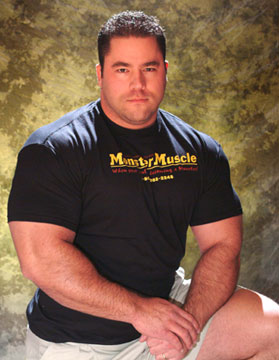
Assistance Lift Notes: The best way to learn how to properly perform the above assistance lifts is to get an experienced powerlifter (or power bodybuilder) to show you. But, for those of you who don’t have that option, here are some notes in regards to technique and form. 4 Board Press: This is where you take four 2×6 pieces of board and stack then on top of your chest. Then, you perform a benchpress, but you’ll be bringing the bar down into the boards and then pressing it back up into lockout. You’ll be using the same style of lifting as you do when regular benchpressing, but you’ll be stopping the bar, on the boards, eight inches off of your chest. This allows you to focus on the lockout portion of the lift and it heavily trains your tricep muscles. Rack Lockouts: Place a flat bench in the power rack. Then, set up the power rack safety rods so that, when the bar is resting on them, it’s about halfway between your chest and lockout. Then, perform your reps by pressing the bar to lockout, using the saftey rods as your starting point. When you bring the bar back down, let it pause on the rack before pressing it back up into lockout. Rack lockouts are similar to board presses in that you’re working the top half of the benchpress movement and this will build strong front delts and triceps. Floor Press: Lay down on the floor inside the power rack (set up the bar hooks in the rack so that you can take the bar out from this position). You’ll perform floor presses just like benchpresses but, instead of bringing the bar down to your chest, you’ll be lowering the bar until your triceps are flat on the ground (the bar will still be above you chest). Floor presses build stability in your muscles and they will build a lot of strength in your triceps. The other assistance exercises that you’ll be training in this program (pushdowns, skull crushers, behind-the-head 2 hand dumbbell extensions, and barbell extensions from the floor) are common bodybuilding exercises and just about any experienced builder should be able to show you how to perform these properly. The only lift that might be unknown amongst the veteran lifters in your gym are barbell floor extensions from the floor. These are performed exactly like skull crushers, except that you’ll be laying on the floor and you’ll be bringing the bar down to the ground over/behind your head and you’ll be keeping your elbows pointed in the same direction that you’re looking, rather than letting them fan out away from your head.
Seanzilla: You’ve come out with an absolutely awesome competition benchpress training book, called The Kennelly Method – Building A Monster Benchpress.
Kennelly: Thank you. I put a lot of time and thought into the writing of this book and I spent many weeks going back and forth over the copy with the editors and graphic designers. The Kennelly Method opens up with my complete lifting history, in detail, up thru my hitting the world record 800.5 pound benchpress. The bulk of the book covers my nutritional plan for strength building, powerlifting equipment, benchpress boards, bands, and chains and how to train with them, pages of primary pressing lifts and assistance exercises,setting up a training cycle, and advice for the day of competition. If someone picks up a copy of my book and consistently follows the program that I’ve laid out within, then they will soon be benchpressing poundages that were previously way out of their reach. The Kennelly Method is a 63 page, full color, paperback book and it’s loaded with instructional photos and detailed training advice.
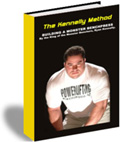
Seanzilla: I’ve heard time and time again that stronger legs mean a stronger benchpress. What has your experience been and what/how do you train legs?
Kennelly: I agree and to get strong legs you have to train them hard and heavy since your glutes are the biggest muscle group in your body. I train legs once per week and I usually work full barbell squats (going below parallel) up to 5 sets, alternating between 5 and 8 reps sets week to week (week 1: five sets of five, week 2: five sets of eight, week 3: five sets of five, ect.). After you tax your legs with squats, you’ll do heavy leg presses for 5 sets of 10 reps. Your legs play an important role in the benchpress and, if you think they don’t, then try benching your current max with your feet off the ground and in the air. Get the point? Your legs are working really hard when you’re benching and leg drive is super important in the starting phase of the press portion of your bench.
Seanzilla: In the gym, I see a lot of people training the portion of the triceps that’s the most visible; the triceps “horseshoe”. I know, from talking with you, that it’s the portion of the triceps that’s directly above the elbow that’s the most important when it comes to locking out the weight in the benchpress. What do you do in the gym to specifically train the muscles & connective tissue that surround the elbow?
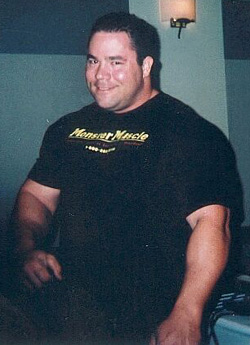
Kennelly: The muscles and tendons that wrap around the elbow and into the upper forearm play a very important role in the benchpress and, most importantly, the lockout. The beefy part of the tricep is what gives the triceps size and so bodybuilders tend to focus their triceps training on building that portion of the muscle group. But, what is overlooked, is the points at which the triceps attach at the elbow. These connective points must be strengthend and developed in order to be able to lockout heavy weight. The best exercise to build this critical area is dumbbell extensions with your palms facing and laying flat on the floor. Start this lift by setting two dumbbells upright on the floor and with one on each side of your head/ears. Grab the dumbbells while keeping your elbows pointing straight up towards the ceiling. Then you will raise the dumbbells by extending your arms, locking out your triceps at the top. During this exercise, always keep your elbows pointing straight up (don’t allow your elbows to flare out). When you lower the dumbbells, do it slowly and wait till the bounce comes out of them when they hit the floor before starting another rep. I recommend starting with very light weight and using high reps when you first start this exercise and then increase the weight as the lift becomes more comfortable and natural in motion.
Seanzilla: Deadlifters are famous for having massive forearms. You’re a benchpresser, but you’ve got them also. You’ve told me before that tightly gripping the bar brings more of your arm muscles into play. Please discuss your grip training and the role grip strength plays in benchpressing.
Kennelly: My grip training consists of using two training devices, the SuperGripper and the wrist roller. Most gyms should have a wrist roller available to you and you can pick up a SuperGripper from MonsterMuscle.com (they fit easily in your gym bag). I use the wrist roller and SuperGripper in my training twice per week and I always do high reps until my forearms are burning. I feel that you can’t overtrain your forearms, so I also use the SuperGripper at home while I’m watching television. I train my forearms with intensity because you must squeeze the bar extremely hard during benchpressing in order to activate all of the muscles in the arm. Try benchpressing with your hands completely open on the bar and your will quickly fiqure out why grip strength and squeezing the bar is so important. The harder you sqeeze, the harder your triceps activate and the more lockout power you get, simple.
Seanzilla: One of the best tools ever invented to assist a lifter with building a monster benchpress, are bench boards. Explain the purpose of using different heights of boards. What would be a common training day using regular bench boards and other triceps work.
Kennelly: The main purpose of the bench boards is to break up the benchpress into five different points of the press. For example, you can place the two board onto your chest (note: when training with boards, it’s best to have one training partner steady the boards and another training partner assist you with your handoff). Have your partner hand the bar off to you and lower the bar to the board. Let the bar come to a complete rest on the board and then press the bar back up to a lockout. When a weight is at a dead stop, it takes more power to get it moving upwards than it does to keep it moving upwards (keep your body tight though when the bar is paused on the boards). By working on pressing from two board heights above your chest, you will develop explosive power at that height and your compettion press will exhibit more force when the bar passes upwards through this portion of the lift. Everyone has a sticking point in the bench. In my lifting career, my worst sticking point has been when the bar is six inches from lockout. For me, this is the height of four boards so I trained a lot with the four board press and overcame this sticking point. Remember, when you use the boards on the bench, you must pause when you reach the board. Then, when you start pressing, explode straight up. Again, the main purpose of the boards is to build and strengthen your lockout power by overcoming sticking points in your press.In training it is wise to do 5 sets of 5 reps on the boards and then, after one month (four heavy training days) switch to 5 sets of 3 reps using heavier weight. When training with boards, always use a close or medium grip to ensure that you build tremendous strength in your triceps.
To build these boards, go to your local hardware store and purchase some 8 foot 2×6 plank boards and cut them in to 3 foot sections (some hardware stores, like Home Depot, will cut them for you for a nominal fee). Then use wood screws to screw the boards together. Make sure that you’re using a length of screw that will tightly secure the boards together without sticking out the other end (you don’t want a screw point being pressed into your chest when you’re benching!) If you don’t have access to a power drill, you can also seal the boards together using carpenter’s wood glue. Glue the boards together, set something heavy on top of them, and then let them sit and dry for 24 hours.
Seanzilla: In addition to being the first benchpresser in history to bench 800 pounds, you’ve managed to build the kind of physique that a lot of lifters would like to build; lots of muscle, massive arms, relatively low bodyfat, and an upper back & shoulders that are a lot wider than your waistline. Obviously, a lot of your muscle mass comes from your hardcore training, but I also assume that your diet and nutritional supplementation have played a major role in your success. Please outline a typical day in your benchpress competition prep diet plan.
Kennelly: My daily nutritional program is a high powered combination of healthy food and nutritional supplements. Here is a list of what and when I eat each day during the 90 day period that I gear up for a contest. Meal One: 1 bowl of rolled oats, six hard boiled egg whites, one glass of juice and one glass of milk Meal Two: 1 Eclipse “The Shake” RTD protein drink, 1 Eclipse Complex 24 Multi-Vitamin tablet and some essential fatty acid capsules Meal Three: 1 can of tuna fish mixed in with a green salad and 5 grams of Eclipse Creatine Monohydrate mixed into 1 glass of water Meal Four: 1 Eclipse “The Shake” RTD protein drink and 1 Eclipse Complex 24 Multi-Vitamin tablet Meal Five: An 8-16 oz. steak, two pieces of whole wheat toast and a glass of water Meal Six: 5 grams of glutamine mixed in with a glass of orange juice and 5 grams of creatine mixed in with a glass of water Meal Seven: An 8 oz. hamburger on a whole wheat bun, a green salad, some fresh fruit, and a glass of water Meal Eight: An Eclipse “The Shake” RTD protein drink Meal Nine: 5 grams of Eclipse Glutamine Powder mixed with orange juice and 2 Eclipse Humatropil p.o capsules Meal Ten: Six hard boiled egg whites, a glass of milk, and a glass of water
With the help from Eclipse Sports Supplements, I’ve benchpressed 700+ pounds in competition 29 times and I’ve reset my personal record to a competition benchpress of 804.5 pounds. I recently benchpressed this at the WABDL World Championships in Las Vegas and now I’m setting my sights on defending my WPO Heavyweight Title at the upcoming Arnold Schwarzenegger Classic.
Seanzilla: What new techniques/lifts have you been experimenting with?
Kennelly: Two of the new training practices I’ve recently been employing in my training are the use of weight releasers and training in the benchshirt every other weekend on heavy bench day. Weight releasers will teach you to lower heavier weights and train the descent part of the press. Weight releasers are hooks with angled bases. You can attach weight to them and then they release from the bar when the bar touches down onto your chest. When training with these, we put 80% of our one rep max on the bar and then we hook on the weight releasers with a certain amount of weight ( the amount of weight varies depending on the lifter and on where we are in our training cycle). This is can also be done with the use of a benchshirt which I highly recommend, at this percentage. The working sets with the weight releasers are done for singles. On the heavy days that I’ve recently been putting in with my benchshirt, I’ve been working sets of triples.
Seanzilla: You’ve got a lot of knowledge to share with other benchpressers. What are you upcoming plans for communicating with the hardcore lifting subculture?
Kennelly: Well, I’m only in my late 20’s so I’m right in the middle of my professional benchpressing career. Thus, I plan on continuing to compete at pro competitions and I’ll continue to guest lift at amateur ones. I love attending these competitions because it gives me a chance to interact with hundreds of other lifters and we get to share ideas and tell stories. I learn a lot from these other lifters and I hope that they get a lot out of chatting with me as well. I’m also looking into setting up training seminars in the near future. If I can put that together, then that will give me more opportunities to work with other benchpressers. I’ve also started looking into the possiblity of having a BenchMonster training video produced. This is just in the drawing board stages and I’m hoping to unleash it sometime late this year. The video will be a great training companion to my training book that was published. Once a lifter has my book, and read through it, they can log on to my web forum at BenchMonster.com and ask questions that can be fielded by me and other lifters. The BenchMonster.com forum has hundreds of benchpressers posting on it and it’s a great way to get your specific training questions answered after you’ve read the book.
Seanzilla: Is there any more knowledge that you’d like to drop on us this time around?
Kennelly: The best plan that an aspiring benchpresser can follow is this; for your nutrition plan, follow the previously outlined food and Eclipse supplement schedule. I’m weighing roughly 300 pounds, so you can adjust the caloric intake to your own bodyweight by working out the percentages. You can follow the supplement plan as outlined and then cut back on your calories by eating smaller portions of food if needed. Eclipse Sports Supplements makes the best products in the industry. Like I’ve said before, when I hit my world record benchpress and then won the Arnold Schwarzenegger Benchpress Championships, I got a lot of offers from nutritional supplement companies. I had the luxury of choosing from some of the best and I chose Eclipse because their products are awesome! For building your training knowledge base, continue reading BodyTalk Magazine, pick up a copy of my Kennelly Method benchpress training book, and get yourself a subscription to Monster Muscle Magazine. Monster Muscle is the #1 powerlifting and strongman magazine in the USA and the routines and information contained within will be geared toward getting stronger rather than wasting your time with fitness fluff. A year’s subscription to Monster Muscle is only $15 and you can subscribe by calling 1(800)268-2248. If you train with the Kennelly Method, update your program from BodyTalk and Monster Muscle articles, and follow the nutrition program that I outlined for you in this interview, then you’ll be soon be adding a lot of pounds to your max benchpress and you’ll be building dense, quality muscle in the process. Thanks for reading this interview and I look forward to visiting with you at the next benchpress competition.
About Ryan Kennelly – Ryan Kennelly is the current Arnold Classic/WPO Benchpress Heavyweight Champion. He was the first benchpresser to officially benchpress 800+ pounds (he benchpressed 800.5 pounds at the 2002 MonsterMuscle.com WABDL North American Championships in Portland, Oregon). Kennelly recently broke his own record with an awesome 804.5 pound benchpress at the 2003 WABDL World Championships in Las Vegas, Nevada. Ryan Kennelly has officially benchpressed 700+ pounds 29 times in competition. That’s more times than any other benchpresser in history.






